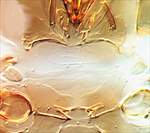
parvulus female

arake

moundi head

okajimai

orientalis

parvulus

tuberculatus head

verruculus male

barbatus pronotum

moundi pronotum

verruculus pronotum

barbatus metanotum & pelta

arake metanotum & pelta

moffati metanotum & pelta

moundi metanotum & pelta

okajimai metanotum & pelta

tuberculatus thorax

verruculus metanotum & pelta

moundi tergites

orientalis prosternites

parvulus prosternites

tuberculatus male tergites

Strepterothrips spp. antennae
Generic diagnosis
Small dark, usually apterous Phlaeothripinae with complex body sculpture. Head longer than wide, genae usually extending around eyes, postocular setae small; maxillary stylets retracted to eyes, close together medially. Antennae 7-segmented, segment III often small with 0, 1 or rarely 2 sense cones, IV usually with 2 sense cones. Pronotum major setae small and capitate; notopleural sutures complete or incomplete. Prosternal basantra absent or weak, ferna transverse; mesopresternum usually absent, anterior margin of mesoeusternum sometimes eroded; metathoracic sternopleural sutures absent. Metanotum often with many small setae. Fore tarsal tooth absent in both sexes, but major males with greatly prolonged claw-like hamus. Fore wing sharply curved at basal third, without duplicated cilia. Pelta variable, hat-shaped to oval and transverse; tergites with transverse row of setae, posteromarginal setae broadly capitate. Male sternite VIII without pore plate.
Nomenclatural data
Strepterothrips Hood, 1934: 431. Type species Strepterothrips conradi Hood, 1934, by monotypy.
There are 15 species described in this genus (ThripsWiki, 2022).
Australian species
Strepterothrips apterus Okajima, 1976: 14
Strepterothrips arake Mound & Tree, 2015: 333
Strepterothrips barbatus Mound & Tree, 2015: 333
Strepterothrips moffati Mound & Tree, 2015: 335
Strepterothrips okajimai Mound & Tree, 2015: 335
Strepterothrips orientalis Ananthakrishnan, 1964: 118
Strepterothrips parvulus Mound & Tree, 2015: 339
Strepterothrips tuberculatus (Girault, 1929: 2)
Strepterothrips verruculus Mound & Tree, 2015: 340
Relationship data
Several Strepterothrips species share with Lissothrips species the condition of antennal segment III being unusually small. However, Strepterothrips together with Azaleothrips are considered to be members of the Idiothrips-complex of Phlaeothripinae.
Distribution data
Species of this genus have been described widely around the tropics, from Central America, Africa and Asia. However, seven of the 15 described species are known only from Australia, with a further species shared between southern Australia and New Zealand, and another that is widespread from India to Malaysia, Indonesia, southern Japan, Hawaii and northern Australia.
Biological data
Members of this genus are all known from dead branches where they presumably are fungus-feeding.
References
Mound LA & Tree DJ (2015) Fungus-feeding Thysanoptera: Phlaeothripinae of the Idiothrips genus-group in Australia, with nine new species. Zootaxa 4034 (2): 325–341.
ThripsWiki (2022) ThripsWiki - providing information on the World's thrips. Available from: http://thrips.info/wiki/ (Accessed 15.iii.2022)